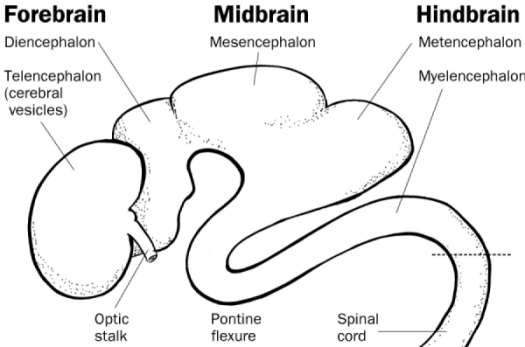

|
|
Neurulation
|
Primary vesicles |
Secondary vesicles |
Adult structures |
|
Forebrain vesicle (prosencephalon) |
Telencephalon |
Cerebral hemispheres, consisting of the cortex and medullary center, basal ganglia, lamina terminalis, hippocampus, the corpus striatum, and the olfactory system |
|
|
Diencephalon |
Thalamus, epithalamus, hypothalamus, subthalamus, neurohypophysis, pineal gland, retina, optic nerve, mamillary bodies |
|
Midbrain vesicle (mesencephalon) |
Mesencephalon |
Midbrain |
|
Hindbrain vesicle (rhombencephalon) |
Metencephalon |
Pons and cerebellum |
|
|
Myelencephalon |
Medulla |

Figure 5 - Structure of embryonic brain
The neural tube consists of three cellular layers from inner to outer: the ventricular zone (ependymal layer), the intermediate zone (mantle layer), and the marginal zone (marginal layer). The ventricular zone gives rise to neuroblasts (future nerve cells) and glioblasts (future supporting cells) which migrate into the intermediate zone form two collections of cells (the alar plate and the basal plate) separated by a groove called the sulcus limitans. Cells in the alar plate become afferent (sensory) neurons and form the dorsal (posterior) horn of the spinal cord. Cells in the basal plate become efferent (motor) neurons and form the ventral (anterior) horn of the spinal cord. The two ventral horns bulge ventrally to create ventral median fissure. The dorsal horns merge to create the dorsal median septum. The lumen of the neural tube becomes the central canal of the spinal cord.
The spinal cord extends the entire length of the vertebral canal at week 8 of development. At birth, the conus medullaris extends to the L3 vertebra. In the adult, the conus medullaris extends to the L1 vertebra. Spinal lumbar punctures must be performed caudally to the conus medullaris to avoid damaging the spinal cord.
The dura mater arises from paraxial mesoderm that surrounds the neural tube. The pia mater and arachnoid mater arise from neural crest cells.
The anterior pituitary gland (adenohypophysis) arises from an evagination of the oropharyngeal membrane known as Rathke’s pouch. The posterior pituitary gland (neurohypophysis) arises from an evagination of neuroectoderm from the diencephalon.
· Spina bifida occulta is a defect of the vertebral column only, and is a common problem affecting as many as 10% of live births.
· Spina bifida with meningocele (spina bifida cystica) is a defect of the vertebral column with protrusion of the meninges through the defect.
· Spina bifida with myelomeningocele is a defect of the vertebral column protrusion of the meninges and herniation of the spinal cord through the defect.
· Spina bifida with myeloschisis results from the failure of the caudal neuropore to close at the end of the fourth week of development. Newborn infants are paralyzed distal to the lesion.
These defects usually occur in the cervical and/or lumbar regions and may cause neurologic deficits in the lower limbs and urinary bladder. Neural tube defects can be detected by the presence of alpha-fetoprotein (AFP) in the fetal circulation after the fourth week of development.
Anencephaly is the failure of the anterior neuropore to close, resulting in a failure of the brain to develop.
Microcephaly (small head) results from microencephaly (small brain), or the failure of the brain to grow normally. This can be the result of exposure to large doses of radiation up to the sixteenth week of development, or from certain infectious agents (cytomegalovirus, herpes simplex virus, and toxoplasma gondii)
Hydrocephalus is an accumulation of CSF in the ventricles of the brain, caused most commonly by stenosis of the cerebral aqueduct. In the absence of surgical treatment in extreme cases the head may swell to three times its normal size.
Arnold-Chiari malformation is herniation parts of the cerebellum (medulla oblongata and cerebellar vermis) through the foramen magnum of the skull.
|
|